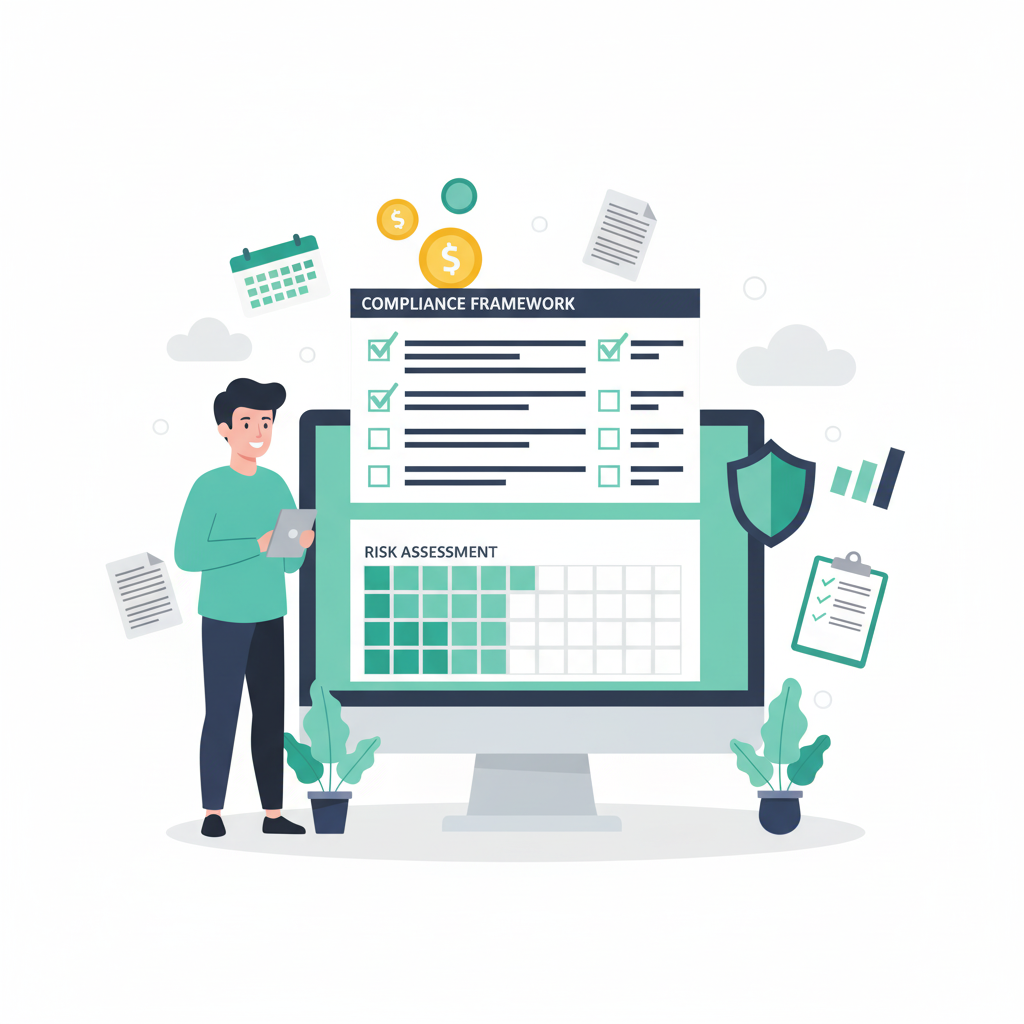You’ve spent years building software. You know how to break down features, estimate timelines, and ship code. Then enterprise customers start asking for SOC 2 reports and ISO 27001 certificates, and suddenly you’re in unfamiliar territory.
Compliance feels different because it is different. There’s no Sprint Zero for risk assessments. You can’t MVP your way through an audit. The timeline stretches to 6-12 months and the budget lands somewhere between $50K and $250K annually.
But compliance is still a project. It has phases, deliverables, and acceptance criteria. This comprehensive guide is part of our regulatory compliance overview, where we explore the complete landscape of tech regulation. This article gives you the frameworks to execute it: risk assessment templates, data mapping guides, audit preparation checklists, and a timeline roadmap with milestones.
We’re assuming you’re running a 50-500 person tech company in SaaS, FinTech, HealthTech, or EdTech. Let’s turn this overwhelming requirement into something you can plan, budget, and ship.
What is a compliance programme and why do tech companies need one?
A compliance programme is a structured system of policies, procedures, controls, and governance mechanisms that proves you’re meeting regulatory requirements. Not “we think we’re secure” but “here’s documented evidence we’re secure.”
Three things drive this need. First, enterprise customers won’t sign contracts without certifications. Your sales team hits procurement and gets blocked until you produce a SOC 2 report. Second, regulatory obligations kick in when you have EU customers (GDPR), handle healthcare data (HIPAA), or operate in regulated sectors. Third, investors expect proper controls during due diligence.
The consequences stack up fast. Enterprise deals stall in procurement. GDPR violations can cost up to €20 million or 4% of global revenue. CCPA penalties range from $2,500 to $7,500 per violation.
A compliance programme encompasses risk assessment, security policies, technical controls, evidence collection, and audit preparation. Unlike ad-hoc security, it requires systematic documentation, regular reviews, and external validation.
For SMB tech companies, this means balancing enterprise requirements against resource constraints.
How much should you budget for compliance in a 50-500 person tech company?
Budget planning splits into four categories. Personnel costs run $80K-$180K annually. GRC platforms cost $12K-$60K annually. External audit fees range from $20K-$100K. Consultant support adds $20K-$80K.
Budget ranges by company size: 50-100 employees need $50K-$150K, 100-250 employees need $100K-$200K, and 250-500 employees need $150K-$250K.
First-year costs run higher. You’ll pay $10K-$30K for gap assessment, $15K-$40K for policy development, $20K-$60K for control implementation, and 15-25% premium on first audit. Annual ongoing expenses drop to 30-40% of first-year budget once established.
Budget by framework: SOC 2 Type I costs $40K-$80K first year, Type II runs $60K-$120K, ISO 27001 needs $80K-$150K, and GDPR compliance adds $20K-$50K.
For ROI justification, look at blocked pipeline. Average enterprise deal size runs $50K-$500K. Certification reduces sales cycles by 2-4 months. Cyber insurance premiums drop 10-20%.
Companies with revenue between $5M-$50M should allocate 1-3% to compliance. In-house compliance lead costs $120K-$180K, fractional officer runs $80K-$120K for 0.5 FTE, consultants cost $150-$300 per hour.
GRC platforms reduce manual evidence collection by 60-80% and cut audit prep time by 40-50%. Cost justified at 20+ employees.
Common mistakes: underestimating ongoing maintenance, not allocating 15-20% contingency, attempting manual processes at scale, choosing the cheapest auditor (often results in failed audits).
Should you hire a compliance consultant or build an in-house team?
Your decision hinges on company size, budget, and timeline urgency.
Small companies (50-100 employees): fractional compliance officer at 0.5 FTE ($80K-$120K) plus GRC platform plus external auditor. Avoids full-time overhead while building capability.
Medium companies (100-250 employees): hybrid approach with one in-house lead ($120K-$180K) plus specialist consultants ($20K-$60K) plus GRC platform.
Larger SMBs (250-500 employees): in-house team of 2-3 people ($250K-$400K total) plus GRC platform plus external consultants for specialised frameworks.
Consultant advantages: immediate expertise, no hiring delay, industry best practices, flexible scaling, no long-term commitment. Expect $150-$300 per hour or $20K-$80K projects.
In-house advantages: institutional knowledge retention, ongoing support, better engineering integration, more cost-effective over 3+ years, internal capability building.
Hybrid model works best. Leverage consultants for initial implementation, transition to in-house for ongoing operations, maintain consultant relationships for specialised needs.
Consultants start immediately versus 2-3 months to hire full-time staff.
Hire full-time when maintaining multiple frameworks, over 200 employees, weekly compliance questions, or board requires dedicated resource.
What are the stages of implementing a compliance programme?
Six phases run 6-12 months total. Framework selection and planning (2-4 weeks), gap assessment (3-4 weeks), risk assessment and policy development (6-8 weeks), control implementation and evidence collection (8-12 weeks), internal audit and remediation (4-6 weeks), external audit and certification (4-8 weeks).
Phase 1 – Framework Selection: Determine which certifications customers demand. SOC 2 is most common for SaaS. Industry regulations drive others: HIPAA for HealthTech, PCI DSS for payment processing, GDPR for EU customers. For detailed guidance on choosing your compliance framework, consider your customer geography and industry requirements. Create business case for executive approval. Select GRC platform and auditor.
Phase 2 – Gap Assessment: Document current security posture. Compare against framework requirements. Gap analysis evaluates current capabilities against future goals. Estimate effort to close gaps. Create prioritised remediation roadmap. If you haven’t yet determined which framework to pursue, see our framework comparison and selection guide.
Phase 3 – Risk Assessment and Policy Development: Conduct formal risk assessment identifying threats, vulnerabilities, and impacts. Develop 20-30 security policies covering information security, access control, incident response, data classification, and vendor management. Gain executive approval and employee acknowledgment.
Phase 4 – Control Implementation: Implement technical controls: MFA, encryption, logging, vulnerability scanning, backups. Establish administrative controls: access reviews, security training, change management, incident response. Configure GRC platform for evidence automation. Begin 6-12 month evidence collection (required for SOC 2 Type II). Conduct vendor risk assessments.
Phase 5 – Internal Audit: Test all controls for effectiveness. Review evidence completeness. Identify and remediate gaps before external audit. Conduct tabletop exercises for incident response.
Phase 6 – External Audit and Certification: Select accredited auditor. Provide evidence package. Respond to inquiries. Address findings. Receive audit report or certificate. Distribute to customers.
Evidence collection (6-12 months for Type II) determines earliest audit date. Book auditors 3-6 months in advance.
Common bottlenecks: executive availability for policy approvals, engineering resources, vendor cooperation, evidence gaps discovered late.
Six months is aggressive but achievable for SOC 2 Type I. Twelve months provides comfortable pacing for Type II or ISO 27001.
What is a risk assessment template and how do you use it?
Risk assessment identifies and evaluates security risks, determining likelihood and impact. SOC 2, ISO 27001, and most frameworks require it.
Template structure includes five components:
- Asset inventory covering systems, data, and processes
- Threat identification: external threats (hackers), internal threats (insider errors), environmental threats
- Vulnerability assessment finding security weaknesses, missing controls, configuration issues
- Impact analysis covering financial, reputational, operational, regulatory consequences
- Likelihood rating showing probability based on current controls
Risk scoring multiplies Impact (1-5 scale: negligible to catastrophic) by Likelihood (1-5 scale: rare to almost certain) producing Risk score (1-25). Scores 15-25 are high priority, 8-14 medium, 1-7 low.
Categorise assets as critical (production infrastructure, customer databases, payment systems), important (internal tools, development environments), or supporting (marketing tools, office productivity).
Using the template: populate asset inventory. For each asset, identify relevant threats (database breach, ransomware, DDoS, insider theft). Assess existing controls. Rate inherent risk (before controls) and residual risk (after controls). Prioritise treatment for high residual risks.
Risk treatment options: mitigate (implement controls), accept (document for low risks), transfer (cyber insurance, vendor contracts), avoid (discontinue risky activity).
Risk assessment must be documented, reviewed annually or after significant changes, approved by management, referenced in policies, and used to justify controls.
Time investment: 2-4 weeks with consultant or 4-6 weeks internally. Annual updates require 1-2 weeks.
GRC platforms like Vanta and Drata include risk assessment modules. Spreadsheet-based approaches work for smaller programmes.
Output drives control selection, informs audit scope, justifies budget, demonstrates due diligence, supports cyber insurance applications.
What is data mapping and why is it required for privacy compliance?
Data mapping documents what personal data you collect, where you store it, how it flows, who accesses it, and when you delete it.
GDPR and CCPA both aim to protect personal information. GDPR requires it under Article 30. CCPA demands consumer data inventory. HIPAA needs PHI tracking. SOC 2 privacy criteria require it. For AI systems processing personal data, you’ll also need to conduct a DPIA for AI systems under GDPR Article 35.
Five key elements:
- Data inventory: names, emails, payment info, health records, location, IP addresses
- Data flow diagrams: collection points, processing systems, storage locations, third-party transfers, deletion processes
- Purpose documentation: why each data type is collected and legal basis
- Access controls: who and which systems can access each category
- Retention schedules: how long data is kept and deletion procedures
Creating your data map: identify all collection points (website forms, mobile apps, API integrations, third-party tools). Interview product and engineering teams. Document data at rest (databases, file storage, backups, logs) and data in motion (API calls, third-party sharing). Map third-party processors (payment providers, email services, analytics, hosting). Document retention and deletion.
Visual representation: user → collection point → processing system → storage → potential transfers → deletion.
Compliance applications: GDPR data subject access requests (retrieve all data about individual), GDPR right to deletion (delete across all systems), data breach notifications (know what data exposed), privacy policy accuracy (reflect actual practices).
Update when launching features, adding third-party tools, changing retention, or expanding to new regions. Quarterly review recommended.
Common gaps: data in logs not documented, third-party tools collecting data without privacy review, backup retention exceeding policy, shadow IT, development environments with production data.
Time investment: 3-6 weeks for typical SaaS product. Complex flows in FinTech or HealthTech may require 6-10 weeks.
What audit preparation steps are required for SOC 2 certification?
Pre-audit timeline: minimum 6-12 months for Type II (continuous evidence collection), 3-6 months for Type I (point-in-time). Rushing leads to failed audits.
Documentation requirements: complete policy suite covering 20-30 areas (information security, access control, change management, incident response). Evidence through screenshots, logs, tickets, training records, access reviews, vulnerability scans, penetration tests. Organisational charts and role descriptions. System descriptions and data flow diagrams. Vendor contracts and SOC 2 reports.
Evidence by trust service category. Security (mandatory): access logs, MFA enforcement, encryption configs, vulnerability scans, penetration tests, incident response exercises. Availability (optional): uptime monitoring, backup logs, disaster recovery tests. Processing Integrity (optional): data validation, error monitoring. Confidentiality (optional): NDA tracking, data classification. Privacy (optional): data mapping, privacy policy, consent management.
Control testing: select sample period (Type II requires 6-12 months). Test each control for effectiveness. Document results. Identify gaps. Remediate before external audit. Re-test remediated items.
Common failures: insufficient evidence (controls documented but not performed), evidence gaps (missing months), inconsistent policy implementation, vendor management deficiencies (using vendors without SOC 2 reports), access control violations.
Audit preparation checklist: policies approved and communicated (100% acknowledgment), 6-12 months continuous evidence (no gaps), all vendors assessed (SOC 2 reports on file), security training completed (100%), vulnerability management current (no findings older than 30 days), access reviews completed (quarterly), incident response tested (annual tabletop), backups tested (quarterly restore), change management logs complete, internal audit completed (findings remediated). Documented compliance efforts also help reduce personal liability through compliance by demonstrating good faith risk management.
Auditor selection: choose AICPA-accredited firms, check references, understand pricing (fixed-fee versus hourly), confirm availability (book 3-6 months ahead), clarify scope and timeline.
Internal audit value: pre-audit by consultant identifies gaps. Typically costs $10K-$25K but prevents $50K+ re-audit costs.
GRC platforms automate 60-80% of evidence collection by integrating with AWS, GitHub, Google Workspace, Jira. Provide audit readiness dashboards and organise evidence by control.
Audit timeline: kickoff (week 1), documentation review (weeks 1-2), evidence collection and testing (weeks 2-6), management responses (weeks 6-7), draft report (week 7), final report (week 8).
Post-audit: distribute SOC 2 report to customers via secure portal, add to sales collateral, prepare for annual recertification, begin continuous monitoring.
How do you choose the right GRC platform for your organisation?
GRC platforms automate evidence collection, policy management, risk assessment, audit preparation, and monitoring. Typical vendors: Vanta, Drata, Sprinto, Scrut, Secureframe.
Decision framework uses five factors: framework support (SOC 2, ISO 27001, GDPR, HIPAA, PCI DSS), integration capabilities with your tech stack, pricing and budget fit, company size, and support resources.
Framework coverage: Vanta and Drata support widest range. Sprinto and Scrut are strong in core frameworks. Secureframe is competitive across major frameworks. Assess based on your 12-24 month roadmap.
Integration requirements: verify platform integrates with your infrastructure—AWS, Azure, or GCP; GitHub or GitLab; Jira or Linear; Google Workspace or Microsoft 365; Slack; HR systems like BambooHR or Workday; monitoring tools like DataDog or PagerDuty. Poor integrations mean manual evidence upload.
Pricing typically runs $1K-$5K+ monthly ($12K-$60K annually) based on employee count (50-500), frameworks pursued, integration complexity. Most vendors tier pricing with volume discounts.
Build versus buy: GRC platform justified at 20+ employees or multiple frameworks. Automation reduces manual effort, minimises error, ensures continuous readiness. Saves 60-80% of manual evidence collection time. ROI breaks even within 6-12 months.
Vendor differentiation: Vanta (market leader, premium pricing, extensive integrations), Drata (strong competitor, comparable features, competitive pricing), Sprinto (SMB-focused, competitive pricing), Scrut (risk management emphasis), Secureframe (balanced features and pricing).
Evaluation process: demo 3-4 platforms, verify integrations, request customer references (similar size and industry), test with trial, compare pricing including implementation, assess support, decide and implement 2-3 months before audit.
Common mistakes: selecting platform not supporting your frameworks, insufficient integrations requiring manual work, choosing based solely on price, not budgeting for implementation time.
Implementation timeline: onboarding and integration 2-4 weeks. Evidence collection begins immediately but requires 6-12 months for Type II. Policy library customisation and risk assessment configuration 2-3 weeks.
Alternative: manual compliance viable for very small teams (under 20) or single framework. Expect 40-60 hours monthly for evidence collection.
Platform ROI: (staff hours saved monthly × hourly rate) minus platform monthly cost equals net monthly benefit. Typical savings 20-40 hours monthly at $50-$100 per hour, equalling $1K-$4K monthly value.
What are the key components of a compliance implementation roadmap?
Implementation roadmap outlines phases, milestones, dependencies, resource requirements, and timeline from initiation to certification.
Essential elements: framework and timeline selection (which certifications, target audit date), resource allocation (in-house team, consultants, GRC platform, auditor), phase breakdown with deliverables and acceptance criteria, risk identification and mitigation, budget tracking, stakeholder communication plan.
Phase 1 – Initiation and Planning (2-4 weeks): Business case approved, frameworks selected, budget allocated, team identified, GRC platform selected, auditor engaged, kickoff held.
Phase 2 – Gap Assessment (3-4 weeks): Current state documented, gaps identified, remediation plan prioritised, effort estimated, risks identified.
Phase 3 – Risk Assessment and Policy Development (6-8 weeks): Formal risk assessment completed, 20-30 security policies drafted and approved, employee training and acknowledgment (100%), risk treatment plans documented. Understanding the Australian enforcement trends can help you prioritize which risks require most urgent attention.
Phase 4 – Control Implementation and Evidence Collection (8-12 weeks): Technical controls implemented (MFA, encryption, logging, monitoring, backups, vulnerability management), administrative controls established (access reviews, security training, change management, incident response), GRC platform configured and collecting evidence, vendor risk assessments completed.
Phase 5 – Internal Audit and Remediation (4-6 weeks): Control testing completed, evidence reviewed, gaps identified and remediated, audit readiness validated.
Phase 6 – External Audit and Certification (4-8 weeks): Evidence provided to auditor, inquiries answered, findings addressed, SOC 2 report or ISO 27001 certificate received.
Timeline estimates: SOC 2 Type I achievable in 4-6 months with dedicated resources and consultant support. Type II requires minimum 6-12 months due to evidence period. ISO 27001 typically 9-15 months due to broader scope.
Resource loading: Phase 1-2 consultant-heavy (40-60 hours). Phase 3 cross-functional involving legal, engineering, IT (80-120 hours). Phase 4 engineering-intensive (120-200 hours). Phase 5-6 compliance lead intensive (60-100 hours).
Milestone tracking: define clear milestones at phase transitions. Use project management tools (Jira, Asana, Monday) to track progress. Weekly status meetings during active phases. Monthly executive updates.
Common failures: underestimating evidence collection period, not booking auditor early enough, insufficient resource allocation, scope creep (adding frameworks mid-stream), skipping internal audit, poor communication.
FAQ Section
What happens if my company fails a compliance audit?
No certification issued. Cannot market SOC 2 or ISO 27001 compliance. Enterprise sales pipeline stays blocked. Remediation requires 3-6 months. Re-audit costs $20K-$50K+ additional. Beyond operational impacts, failed audits can increase exposure to personal liability for CTOs by demonstrating inadequate risk management.
Most auditors work collaboratively to address gaps before final report. Complete failures are rare with proper preparation. If significant findings emerge, delay audit to remediate rather than proceed to certain failure.
How long does it take to get SOC 2 compliant?
SOC 2 Type I achievable in 3-6 months with dedicated resources, consultant support, and GRC platform. Type II requires minimum 6-12 months because auditor must observe controls operating over time.
Timeline: 2-4 weeks planning and gap assessment, 2-3 months policy development and control implementation, then 6-12 months evidence collection. Total: 9-15 months from start to Type II certification.
Can I do compliance myself or do I need to hire someone?
Very small teams (under 30 employees) pursuing single framework can manage internally with significant time commitment (20-40 hours monthly) using GRC platform. However, lack of expertise often leads to failed audits.
Recommended: use consultant for initial gap assessment and roadmap ($10K-$30K), implement with internal team supported by GRC platform, bring consultant back for pre-audit review. Full in-house team justified at 100+ employees or multiple frameworks.
What compliance frameworks do enterprise customers expect to see?
SOC 2 Type II is virtually universal requirement for SaaS companies selling to enterprise customers. ISO 27001 increasingly requested by international customers or highly regulated industries.
Industry-specific: HIPAA for HealthTech handling PHI, PCI DSS for payment processing, GDPR for EU customers, FedRAMP or CMMC for government sector. Start with SOC 2, expand based on customer pipeline demands.
What are the most common compliance mistakes small tech companies make?
Starting too late (beginning when enterprise deal in pipeline rather than 6-12 months ahead), choosing cheapest auditor resulting in failed audits and re-audits, attempting manual processes without GRC platform automation, insufficient evidence collection period (rushing Type II), poor vendor management (using vendors without SOC 2 reports), not conducting internal audit before external audit, treating compliance as one-time project rather than ongoing programme, inadequate resource allocation.
How do I justify compliance budget to my CEO and board?
Build business case emphasising revenue impact. Quantify blocked pipeline (enterprise deals requiring SOC 2). Calculate sales cycle reduction (2-4 months faster close). Competitive positioning (required for enterprise market entry). Risk mitigation (regulatory penalty avoidance, breach cost reduction, cyber insurance savings 10-20%). Customer trust and retention. Investor expectations.
Frame as revenue enabler. Show ROI: if certification enables $500K in enterprise revenue, $100K compliance investment has 5x return.
Should I use a compliance automation platform or manual processes?
Automation platform (Vanta, Drata, Sprinto) justified at 20+ employees or multiple frameworks. Platforms save 60-80% of evidence collection time, reduce audit prep time 40-50%, improve audit success rates, enable continuous monitoring, typically achieve ROI within 6-12 months.
Manual processes viable only for very small teams (under 20) with single framework and high tolerance for administrative burden (40-60 hours monthly). Most companies over 30 employees find automation necessary.
What compliance do I need before I can sell to enterprise customers?
Minimum viable compliance for enterprise SaaS: SOC 2 Type II, security questionnaire responses (often 100+ questions), privacy policy compliant with GDPR and CCPA, terms of service and data processing agreement, basic security controls documented (encryption, access controls, backups).
Additional requirements by industry: HIPAA for healthcare customers, PCI DSS if handling payment data, ISO 27001 for international or highly regulated customers. Start SOC 2 process 9-12 months before expecting enterprise deals.
When should I start working on compliance for my tech company?
Begin compliance 6-12 months before expecting enterprise customer requirements or regulatory obligations.
Trigger points: pivoting to enterprise market, enterprise prospects requesting SOC 2 in security reviews, expanding to regulated industries (FinTech, HealthTech), raising significant funding (Series A or B investors expect compliance roadmap), operating in regulated geographic markets (EU requires GDPR compliance).
Don’t wait until enterprise deal is pending. Certification takes 6-12 months minimum.
How do I know which compliance framework is right for my industry?
SaaS: SOC 2 Type II (mandatory for enterprise), ISO 27001 (international expansion), GDPR (EU customers).
FinTech: SOC 2 plus PCI DSS (payment processing) plus state money transmitter licences plus GDPR (EU).
HealthTech: HIPAA (mandatory for PHI) plus SOC 2 (customer requirement) plus state privacy laws.
EdTech: SOC 2 plus FERPA compliance (student data) plus state education privacy laws.
B2G or Defence: FedRAMP (federal) or CMMC (DoD supply chain).
Start with customer and regulatory requirements, expand based on market demands.
What should I look for when hiring a compliance consultant?
Evaluation criteria: relevant industry experience (SaaS, FinTech, HealthTech), track record with target frameworks (request references), transparent pricing (fixed-fee versus hourly, $150-$300 per hour or $20K-$80K projects), knowledge transfer commitment (building capability, not creating dependency), availability during audit prep and auditor engagement, communication style fit, practical implementation focus, willingness to work with existing resources.
Red flags: unwilling to provide references, vague scope and pricing, pushing unnecessary frameworks, lack of industry-specific experience.
What documentation is required for compliance audits?
Core documentation: complete policy suite covering 20-30 areas (information security, access control, acceptable use, incident response, change management, data classification, vendor management, business continuity, disaster recovery). Risk assessment with management approval. System descriptions and data flows including architecture diagrams and data mapping. Evidence of control operation: access logs, MFA configs, vulnerability scans, penetration tests, training records, access reviews, change logs, incident tickets, backup logs. Vendor documentation covering contracts, SOC 2 reports, risk assessments. Organisational charts and role descriptions. Employee training and acknowledgment records.
GRC platforms organise and automate most evidence collection.












